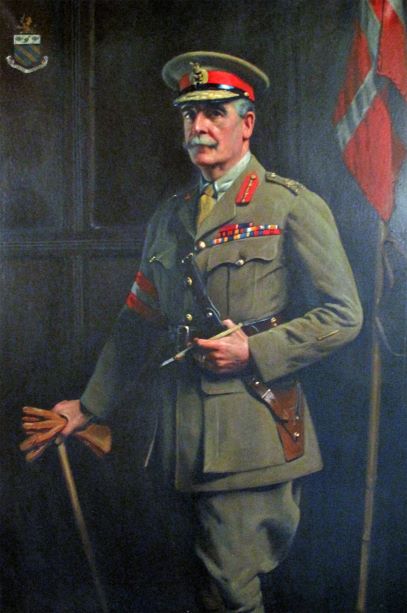
Bulfin was born in Woodtown Park, Rathfarnham, Co Dublin in 1862.
Although he attended Trinity College, Dublin, he did not take a degree, choosing a military career instead.He was commissioned into the Princess of Wales’s Own (Yorkshire Regiment) in 1884. After 30 years of service he became Colonel of the Regiment in 1914.
As Colonel, Bulfin wanted the Regiment to stand out in the Army Lists with a more unique name. He pushed for the traditional nickname of ‘The Green Howards’ to be made official to differentiate between all the other ‘Yorkshire’ Regiments.
He was finally successful in 1921, and the name lasted for the next 85 years.
Explore more memories from the ribbon
-
Captain John Maughan
John was born on the 4th January 1890 at East Witton in North Yorkshire and was the eldest son of John and Annie Maughan. They lived at Abbey Hill, a large house overlooking Jervaulx Abbey near Middleham, North Yorkshire. John senior was the agent for the Jervaulx estate. John was educated at Marlborough College. He was gazetted to a commission in the 4th Battalion, The Yorkshire Regiment in 1909 and was promoted Captain on the 3rd November 1914. John went to France in April 1915 and was in action at the 2nd Battle of Ypres just a few days later. His distinguished service during this action resulted in him being ‘Mentioned in Dispatches’ by Sir John French. On the 12th February 1916 the Battalion occupied trenches around Hill 60 near Ypres. Work was ongoing repairing trenches when on the 14th February the Germans began to bombard them. The enemy also exploded a mine which killed thirteen men. On the 17th February, ironically regarded as a relatively quiet day, some minor shelling resulted in John being hit and killed by shrapnel. Captain John Maughan was buried in Poperinghe New Military Cemetery. John’s name is commemorated on the War Memorial at East Witton.
-
Thomas Cole
Submitted by Olivia Wallis of Richmond. Thomas Cole, son of Ben and Jane Cole, was born in Gainford, Durham in 1882, though the farming family resided in the local village of Newsham. On 9th June 1906, Thomas married Margaret Ellen Watson in St Cuthbert’s Church, Durham and, by 1911, Thomas and Margaret were the parents of Thomas, aged 3, Mary, aged 2, and Ben, aged only 11 months. Following the outbreak of war, though the exact date uncertain, Thomas enlisted at the neighbouring village of Dalton, and joined the 9th Battalion of the Yorkshire Regiment. Throughout his time with the 9th Battalion, Thomas wrote often to his devoted wife and children. In October 1916, Thomas wrote to tell his wife that he had become teetotal, news he expected to surprise his wife, explaining ‘I can’t drink French beer!’ Perhaps more poignantly, Thomas also expressed to Margaret his hopes of the future and a hope that future generations would never suffer the horrors of war. Thomas never got to pursue his hopes, he was killed on 23rd June 1917, aged 35. The battalion war diary for 23rd June does not detail events of that day, it simply collates casualties for the month as 6 men killed, 1 wounded and 2 missing. Private Thomas Cole is buried at Dickebusch New Military Cemetery, Belgium and commemorated locally on the war memorial in Newsham village.
-
L Cpl Thomas M Coates
Thomas was born around 1883 to George and Margaret Coates. George was a farm worker. By 1901 the family was living at Marsett in Raydaleside where Thomas and his two brothers, George and Albert were born. The children attended Stalling Busk School. On leaving school Thomas worked in the Council Offices in Hawes. Thomas enlisted on the 6th October 1915 joining the 4th Battalion Yorkshire Regiment. Thomas would gain the rank of Lance Corporal. On the 26th September 1916 during the latter part of the Somme offensive Thomas won the Military Medal for bravery in the field. However, he was severely wounded. On an attack of a German trench a soldier threw a stick bomb which exploded at Thomas’s feet whereby he received serious wounds to his leg and face. Despite this he still managed to dispatch the German soldier with his bayonet and in doing so saved a colleague. Thomas spent 11 weeks at a hospital at Rouen where he underwent four operations. Two more operations followed in England before he was discharged from the Army on the 14th July 1917. Thomas eventually went back to his old job until he married Elizabeth Watson in 1921. They then went to live at The Heugh, a large isolated house above Nappa Scar near Settle in the Yorkshire Dales. They ran it as a guest house, and it was here that their two daughters, Margaret and Mary, were born. On the 21st January 1925, after only three day’s illness, Thomas died…
